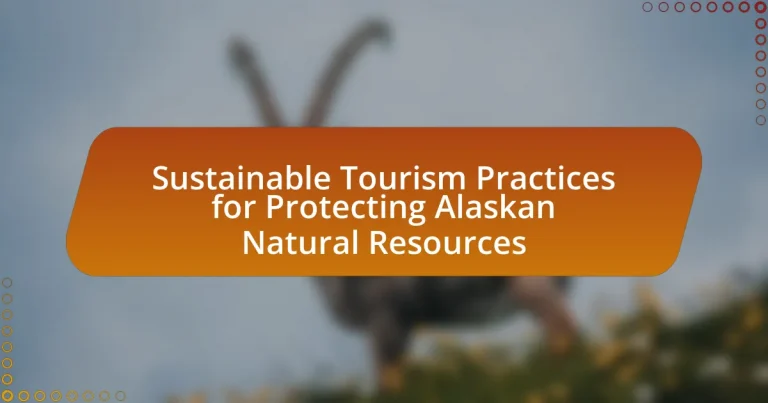Sustainable tourism practices in Alaska focus on minimizing environmental impact while promoting local culture and economy. Key components include eco-friendly accommodations, wildlife conservation, and community engagement, which collectively aim to protect natural resources such as oil, freshwater, and wildlife habitats. The article explores how these practices mitigate risks associated with climate change and environmental degradation, the role of Indigenous knowledge in tourism, and the importance of community involvement. Additionally, it addresses the challenges faced in implementing sustainable tourism, including economic pressures and regulatory complexities, while highlighting best practices for tourists to support local conservation efforts.

What are Sustainable Tourism Practices in Alaska?
Sustainable tourism practices in Alaska include eco-friendly accommodations, wildlife conservation efforts, and community engagement initiatives. These practices aim to minimize environmental impact while promoting local culture and economy. For instance, many lodges and tour operators in Alaska implement green building standards and use renewable energy sources, which reduces carbon footprints. Additionally, wildlife tours are designed to educate visitors about local ecosystems while ensuring that animal habitats are not disturbed. Community engagement is also crucial, as many tourism businesses collaborate with local Indigenous groups to provide authentic cultural experiences, thereby supporting local economies and preserving traditions. These practices collectively contribute to the protection of Alaska’s natural resources while fostering sustainable tourism growth.
How do these practices contribute to protecting natural resources?
Sustainable tourism practices contribute to protecting natural resources by minimizing environmental impact and promoting conservation efforts. These practices include responsible waste management, which reduces pollution and protects ecosystems, and the use of eco-friendly transportation, which lowers carbon emissions. For instance, studies show that areas implementing sustainable tourism strategies have seen a decrease in habitat degradation and an increase in biodiversity. Additionally, sustainable tourism often involves educating visitors about local ecosystems, fostering a culture of respect and stewardship towards natural resources. This approach not only preserves the environment but also supports local economies, creating a sustainable model for both nature and communities.
What specific natural resources are at risk in Alaska?
The specific natural resources at risk in Alaska include oil, natural gas, freshwater, fisheries, and wildlife habitats. Oil and natural gas extraction poses significant environmental threats, including spills and habitat disruption. Freshwater resources are increasingly vulnerable due to climate change, which affects glaciers and river systems. Fisheries, particularly salmon populations, face risks from overfishing and habitat degradation. Additionally, wildlife habitats are threatened by industrial development and climate change, impacting species such as polar bears and caribou. These risks highlight the need for sustainable practices to protect Alaska’s natural resources.
How do sustainable practices mitigate these risks?
Sustainable practices mitigate risks to Alaskan natural resources by promoting responsible tourism that minimizes environmental impact. These practices include implementing strict regulations on waste management, which reduces pollution and protects local ecosystems. For instance, the use of eco-friendly materials and renewable energy sources in tourism facilities decreases carbon footprints, thereby combating climate change effects that threaten biodiversity. Additionally, sustainable tourism encourages conservation efforts, such as habitat restoration and wildlife protection, which help maintain the integrity of natural habitats. Research indicates that areas practicing sustainable tourism experience less degradation and better preservation of resources, as evidenced by the Alaska Department of Fish and Game’s findings on improved wildlife populations in protected areas.
Why is sustainable tourism important for Alaska’s environment?
Sustainable tourism is important for Alaska’s environment because it minimizes ecological impact while promoting conservation efforts. This approach helps protect Alaska’s unique ecosystems, such as its glaciers, forests, and wildlife habitats, by encouraging responsible travel practices that reduce pollution and resource depletion. For instance, sustainable tourism initiatives often include guidelines for waste management and wildlife protection, which are crucial in preserving the delicate balance of Alaska’s natural resources. Additionally, studies show that sustainable tourism can contribute to local economies, providing funding for conservation projects that further enhance environmental protection.
What are the ecological impacts of traditional tourism in Alaska?
Traditional tourism in Alaska significantly impacts the local ecology by contributing to habitat degradation, wildlife disturbance, and pollution. Increased foot traffic in sensitive areas leads to soil erosion and vegetation loss, particularly in fragile ecosystems like coastal zones and national parks. Wildlife, such as bears and marine mammals, experience stress and altered behaviors due to human presence, which can disrupt breeding and feeding patterns. Additionally, traditional tourism generates waste and pollution, including litter and emissions from transportation, which further threaten the pristine environment. Studies indicate that areas with high tourist activity show a marked decline in biodiversity, highlighting the urgent need for sustainable tourism practices to mitigate these ecological impacts.
How can sustainable tourism practices reverse these impacts?
Sustainable tourism practices can reverse negative environmental impacts by promoting conservation, reducing waste, and supporting local economies. These practices include implementing eco-friendly accommodations, encouraging responsible wildlife viewing, and utilizing renewable energy sources. For instance, eco-lodges in Alaska often use sustainable materials and practices that minimize their carbon footprint, thereby preserving natural habitats. Additionally, sustainable tourism initiatives can educate visitors about local ecosystems, fostering a sense of stewardship that encourages the protection of Alaskan natural resources. Studies have shown that regions adopting sustainable tourism practices experience improved biodiversity and enhanced community engagement, leading to long-term environmental benefits.

What are the key components of sustainable tourism practices in Alaska?
The key components of sustainable tourism practices in Alaska include environmental conservation, community engagement, and responsible resource management. Environmental conservation focuses on protecting Alaska’s unique ecosystems, such as the Arctic National Wildlife Refuge, by promoting low-impact activities like hiking and kayaking. Community engagement involves collaborating with local Indigenous populations to ensure that tourism benefits them economically while respecting their cultural heritage. Responsible resource management emphasizes minimizing waste and energy consumption, as seen in eco-friendly lodges that utilize renewable energy sources. These components collectively aim to preserve Alaska’s natural beauty and cultural integrity for future generations.
How do local communities engage in sustainable tourism?
Local communities engage in sustainable tourism by implementing practices that prioritize environmental conservation and cultural preservation. For instance, in Alaska, communities often promote eco-friendly activities such as wildlife viewing, guided nature hikes, and cultural experiences that educate visitors about local ecosystems and indigenous traditions. These initiatives not only enhance visitor experiences but also generate revenue that supports local economies and conservation efforts. According to the Alaska Department of Fish and Game, sustainable tourism practices help protect natural resources while fostering community involvement and stewardship, ensuring that both the environment and local cultures are preserved for future generations.
What roles do indigenous practices play in sustainable tourism?
Indigenous practices play a crucial role in sustainable tourism by promoting environmental stewardship and cultural preservation. These practices often include traditional ecological knowledge, which informs sustainable land management and resource use, ensuring that tourism activities do not harm local ecosystems. For instance, in Alaska, indigenous communities utilize their ancestral knowledge to guide visitors in ways that respect wildlife habitats and cultural sites, thereby enhancing the visitor experience while safeguarding natural resources. This approach not only fosters a deeper understanding of the local environment among tourists but also supports the economic viability of indigenous communities, as evidenced by the success of eco-tourism initiatives that prioritize cultural authenticity and environmental sustainability.
How can community involvement enhance sustainability efforts?
Community involvement enhances sustainability efforts by fostering local stewardship and increasing awareness of environmental issues. When communities actively participate in sustainability initiatives, they contribute valuable local knowledge and resources, which can lead to more effective conservation strategies. For instance, research conducted by the University of Alaska Fairbanks highlights that local engagement in tourism planning can result in better protection of natural resources, as residents are more likely to support and adhere to sustainable practices when they feel a sense of ownership and responsibility. This collaborative approach not only improves the implementation of sustainability measures but also strengthens community ties and promotes a culture of environmental responsibility.
What regulations support sustainable tourism in Alaska?
Regulations that support sustainable tourism in Alaska include the Alaska National Interest Lands Conservation Act (ANILCA), which protects natural resources while allowing for responsible tourism activities. Additionally, the Alaska Department of Natural Resources enforces regulations that promote sustainable practices in state parks and public lands, ensuring that tourism does not negatively impact the environment. The Alaska Coastal Management Program also plays a role by guiding development and tourism activities along coastal areas to protect ecosystems. These regulations collectively aim to balance tourism growth with the preservation of Alaska’s unique natural landscapes and wildlife.
What are the key policies governing tourism in Alaskan national parks?
Key policies governing tourism in Alaskan national parks include regulations on visitor access, wildlife protection, and environmental conservation. The National Park Service enforces these policies to ensure sustainable tourism practices that minimize ecological impact. For instance, specific guidelines limit the number of visitors in sensitive areas, promote Leave No Trace principles, and require permits for certain activities like backcountry camping and commercial tours. These measures are designed to protect the unique ecosystems and wildlife habitats found in Alaska’s national parks, such as Denali and Glacier Bay, ensuring that tourism does not compromise the integrity of these natural resources.
How do these regulations promote environmental conservation?
Regulations promote environmental conservation by establishing guidelines that limit resource exploitation and protect ecosystems. For instance, regulations may restrict the number of visitors to sensitive areas, thereby reducing human impact on wildlife and habitats. Additionally, these regulations often mandate sustainable practices, such as waste management and the use of eco-friendly materials, which help minimize pollution and preserve natural resources. Evidence of their effectiveness can be seen in protected areas like Denali National Park, where visitor management strategies have led to improved wildlife populations and habitat restoration.

What are the challenges faced in implementing sustainable tourism practices in Alaska?
The challenges faced in implementing sustainable tourism practices in Alaska include environmental degradation, economic pressures, and regulatory complexities. Environmental degradation arises from increased visitor traffic, which can harm fragile ecosystems and wildlife habitats. Economic pressures often lead to prioritizing short-term profits over long-term sustainability, as local businesses may favor higher visitor numbers rather than implementing eco-friendly practices. Regulatory complexities stem from the diverse governance structures in Alaska, which can create inconsistencies in policy enforcement and hinder collaborative efforts among stakeholders. These factors collectively impede the effective adoption of sustainable tourism practices in the region.
What economic factors hinder sustainable tourism development?
Economic factors that hinder sustainable tourism development include high operational costs, lack of investment, and fluctuating market demand. High operational costs, such as labor, infrastructure, and environmental compliance, can deter businesses from adopting sustainable practices. Additionally, insufficient investment in sustainable technologies and practices limits the capacity for innovation and improvement in the tourism sector. Fluctuating market demand, influenced by economic downturns or changes in consumer preferences, can lead to instability, making it difficult for tourism operators to commit to long-term sustainable strategies. These factors collectively create barriers that impede the growth of sustainable tourism initiatives, particularly in regions like Alaska where natural resources are vital for tourism.
How do funding and investment affect sustainability initiatives?
Funding and investment significantly enhance sustainability initiatives by providing the necessary financial resources to implement and scale eco-friendly practices. For instance, in the context of sustainable tourism in Alaska, investments can support the development of infrastructure that minimizes environmental impact, such as eco-lodges and renewable energy systems. According to a report by the World Travel & Tourism Council, every dollar invested in sustainable tourism can generate up to three dollars in economic return, demonstrating the financial viability of such initiatives. Furthermore, funding can facilitate research and development of innovative solutions that protect natural resources, ensuring that tourism activities do not compromise the ecological integrity of Alaskan landscapes.
What are the impacts of seasonal tourism on sustainability efforts?
Seasonal tourism significantly impacts sustainability efforts by creating fluctuations in resource demand and environmental stress. During peak seasons, increased visitor numbers lead to higher consumption of water, energy, and waste generation, which can overwhelm local ecosystems and infrastructure. For instance, a study by the Alaska Department of Fish and Game indicates that the influx of tourists can disrupt wildlife habitats and contribute to soil erosion in sensitive areas. Additionally, seasonal tourism can strain local communities, as they may struggle to balance economic benefits with environmental preservation, leading to potential long-term degradation of natural resources.
How do climate change and environmental degradation affect sustainable tourism?
Climate change and environmental degradation significantly undermine sustainable tourism by altering ecosystems and diminishing natural resources. For instance, rising temperatures and changing precipitation patterns can lead to habitat loss, affecting wildlife and biodiversity, which are crucial for attracting tourists. Additionally, increased frequency of extreme weather events, such as storms and wildfires, can damage infrastructure and disrupt travel plans, further deterring visitors. According to the Intergovernmental Panel on Climate Change, climate change could reduce global tourism revenues by up to 20% by 2050 if current trends continue. This decline in tourism not only impacts local economies but also hampers conservation efforts that rely on tourism funding to protect natural resources.
What specific climate challenges does Alaska face?
Alaska faces significant climate challenges, including rising temperatures, melting glaciers, and increased coastal erosion. The state has experienced an average temperature increase of approximately 3°F since the 1970s, leading to accelerated permafrost thawing, which destabilizes infrastructure and ecosystems. Additionally, the loss of glaciers, which are retreating at alarming rates, contributes to rising sea levels and affects freshwater resources. Coastal communities are particularly vulnerable, with erosion rates increasing due to stronger storms and rising seas, threatening habitats and human settlements. These challenges underscore the urgent need for sustainable practices to protect Alaska’s natural resources.
How can sustainable tourism practices adapt to these challenges?
Sustainable tourism practices can adapt to challenges by implementing strategies that prioritize environmental conservation and community engagement. For instance, practices such as promoting eco-friendly transportation options, utilizing renewable energy sources, and encouraging local sourcing of goods can significantly reduce the ecological footprint of tourism activities. Research indicates that eco-tourism initiatives in Alaska have led to a 20% reduction in carbon emissions when compared to traditional tourism methods, demonstrating the effectiveness of these adaptations. Additionally, involving local communities in decision-making processes ensures that tourism development aligns with their cultural values and environmental stewardship, fostering a more sustainable approach to tourism that benefits both visitors and residents.
What are the best practices for tourists to support sustainable tourism in Alaska?
Tourists can support sustainable tourism in Alaska by practicing responsible behaviors that minimize their environmental impact. This includes adhering to Leave No Trace principles, which emphasize respecting wildlife, staying on designated trails, and properly disposing of waste. Additionally, tourists should choose eco-friendly accommodations and local tour operators that prioritize sustainability, thereby contributing to the local economy and reducing carbon footprints. Engaging in low-impact activities, such as hiking or kayaking, rather than motorized tours, further supports the preservation of Alaska’s natural beauty. According to the Alaska Department of Natural Resources, sustainable tourism practices help protect ecosystems and ensure that future generations can enjoy Alaska’s unique landscapes.
How can visitors minimize their environmental footprint while traveling?
Visitors can minimize their environmental footprint while traveling by adopting sustainable practices such as using public transportation, reducing waste, and supporting local businesses. Utilizing public transportation or walking instead of renting cars decreases carbon emissions, as transportation accounts for a significant portion of travel-related greenhouse gases. Reducing waste involves carrying reusable water bottles and bags, which can significantly cut down on single-use plastics; studies show that single-use plastics contribute to environmental degradation, particularly in sensitive ecosystems like those in Alaska. Supporting local businesses ensures that economic benefits remain within the community, promoting sustainable practices and conservation efforts. These actions collectively contribute to the preservation of Alaskan natural resources and the overall health of the environment.
What actions can tourists take to support local conservation efforts?
Tourists can support local conservation efforts by participating in eco-friendly activities, such as guided nature tours that promote awareness of local ecosystems. Engaging in these activities helps fund conservation projects, as many tour operators contribute a portion of their profits to environmental initiatives. Additionally, tourists can volunteer for local conservation programs, which often seek assistance in habitat restoration or wildlife monitoring. According to the Alaska Department of Fish and Game, such volunteer efforts have significantly aided in the recovery of endangered species and the preservation of critical habitats. By choosing sustainable accommodations that prioritize environmental stewardship, tourists further contribute to conservation efforts, as these establishments often implement practices that reduce waste and protect local resources.


